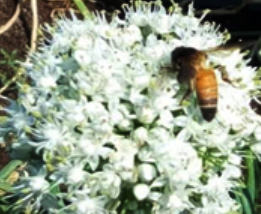प्याज बीज फसल में परागणकों का टिकाऊ प्रबंधन
Onion is highly cross-pollinated crop and flowers are protandrous and therefore self- pollination is largely absent. The event of cross-pollination in onion is mostly rely upon insects foragers particularly honey bees. They are considered as major pollinating agents in onion seed production system.
However, use of synthetic pesticides for managing onion thrips, Thrips tabaci could have an impact on insect pollinating service ultimately reduction in seed yield. Hence, the sustainable way of approach is essentially required for effective management of native pollinators and their eco-system service for quality seed production in onion.
In these article, the basic information about important pollinator species, their role and management is described in details. These information would be very much useful for onion seed growers.
 Insect Pollinators in Onion
Insect Pollinators in Onion
Major pollinators
- Little bee Apis florea Fab
- Indian bee Apis cerana Fab
- Rock bee Apis dorsata Fab
- Western bee Apis mellifera
- Stingless bee Trigona sp
Other pollinators
- Carpenter bee, Wasps, Sulfur and Danais butterfly, Syrphids and Housefly.
Usually, bee foraging visits in onion is overlap with the flower opening time. The peak forage visits occurs in noon hours 12.30 to 15.30. The synchrony between the flower opening and insect forage visit is essential to achieve appropriate pollination.
Prevalence of asynchrony also could possible, especially at the time of peak blooming when less pollinator activity is prolong. The climatic factors, microclimate in and around of crop canopy could have impact on forage visits.
Pollinators management in Onion crop
1. Use crop protection chemicals in sensible way
Use of synthetic insecticides in onion is indispensable as they are essential component to manage the Onion thrips, Thrips tabaci, a principal vector that transmitting deadly Irish Yellow Spot Virus disease in seed onion.
Therefore, insecticides spray schedule should be adopted as window strategies. Application of recommended dose of insecticides viz., profenophos (@ 1 ml / lit), fibronil (@ 1 ml / lit), carbosulfan (@ 2 ml / lit) need to be done with extreme caution till umbel initiation stage and not after flower opening.
In the event of severe increase in thrips population and occurrence of IYSV, bio-insecticides, neem formulation @ 2-3 ml/ lit can be sprayed.
Spray at late evening is advised since the foragers activity is absent during this time so that immediate exposure of bees to this poisionous chemicals is avoidable.
Restrict number of as much as possible
2. Do habitat manipulation and adopt good agronomy practices
- To enhance bees visitation rate, planting of bee attractant crops like mustard, fennel, coriander in and around of onion field is suggested.
- Planting mustard as border/ inter-crop after two weeks of onion bubbling would facilitates subsequent bees visit in onion seed crop. However, these attractant crops should be cut down/ harvested when the umbel initiation is started in seed onion.
- Balanced fertilizer application and maintaining good irrigation management are required to sustain adequate nectar production in onion.
- Too wet and dry fields would results into low amount of nector production, which is not desirble for bees visit.
- Irrigating field at 10-12 days intervals would be optimum in onion seed crop to maintain sound visitation rate.
- The neighboring crops while bloom occurrence should be non attractive to bee.
- Flowering weeds within the onion crops as well as surrounding areas are to be removed since they are attractive to the bees.
3. Use managed bees as pollinators
- Placing bee hives is essential to achieve good pollination. For open-pollinated varieties, bee hives of Apis mellifera or Apis cerana @ 4-6 hives/acre are advised. Place hives when 10 per cent flowers are opened.
- Stingless bee Trigona spp can also supplemented but it requires more number of hives (almost double) as compared to Apis species colonies.
- Hives are to be placed in and around the field, provided proper shade at the top. Always good to keep hives entrance directed towards field interior to ensures the bees working within onion field rather than foraging elsewhere.
- Hives colony with good strength, free of diseases and mites is advised. Frequent inspection of colony is required to ensure the heath of bee hives.
The role honey bees in onion pollination is vital in quality onion seed production. The loss of insect pollinators and their diversity due to man-made activity is irreparable.
The integrated bee management strategies would be effective and efficient in minimizing casualty of pollinators without any further ecological implications.
Authors
Karuppaiah and Soumia, P.S
ICAR-Directorate of Onion and Garlic Research, Pune-410505
Email:
